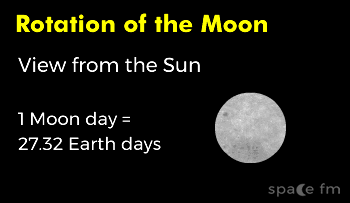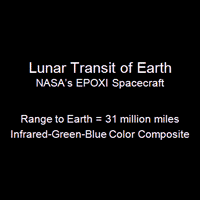Rotation and Orbit
2.6 - Be able to use the rotation and revolution (orbital) periods of the Moon2.7 - Understand the synchronous nature of the Moon’s orbit
4.10 - Understand the difference between sidereal and synodic (solar) months
The Earth rotates in less than 24 hours and travels around the Sun over 365 days.
The Moon orbits the Earth in 27.3 Earth days. A day on the Moon is also 27.3 Earth days long.
The orbit and rotation period of the Moon are identical - 27.3 days.
The Moon has a synchronous (or captured) rotation which means it keeps the same side or face towards the body it orbits. This means that from Earth only one side or hemisphere can be seen.
The Moon has a day and night and receives sunlight on every area of its surface; an exception to this are deep craters at the poles which remain in permanent darkness.
Sidereal and Synodic (solar) months
A sidereal month is the time the Moon orbits the Earth as respect to the background stars.
A synodic month is the period between the same phase (e.g. Full Moon to Full Moon). This is longer because the Earth (and Moon) is also orbiting the Sun. We see two full Moons 29.5 days apart.
The Future
The Moon was closer to the Earth (it is now moving away from us at 4cm a year) and spun on its axis more quickly. Tidal forces slowed down the Moon's rotation. Tidal friction performs as a brake on the Earth's rotation and eventually in billions of years the Earth day will be 55 of our present days long and so will the Moon's. The Moon will appear to hang in the same position in the sky. When this happens, the Moon will be said to have a synchronous orbit as well as synchronous rotation.
Animation
Questions
- What is the name given to the type of rotation of the Moon around the Earth?
- Why can we only see one side of the Moon?
- How long is a day on the Moon?
Did you know?
The Moon orbits Earth in 27 Earth days, 7 Hours, 43 minutes and 7 seconds.
See Also
Links
- EarthSky Watch a full rotation of the moon
- Bad Astronomy Overview of the Moon's rotation
- University of Virginia Sidereal and Synodic Month
- University of Nebraska-Lincoln Sidereal vs. Synodic Motions



 | © All Rights Reserved |
| © All Rights Reserved |